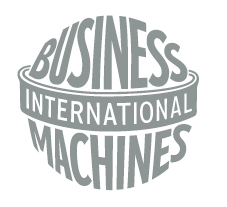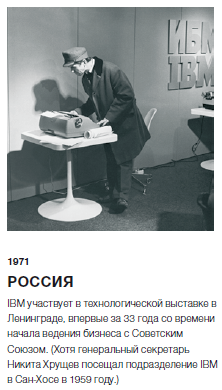Live a hundred years and not grow old
 The company logo you are looking at in 2010 was estimated at $ 64.7 billion US dollars. If you divide this amount into 100 years of IBM's existence, then it turns out that every year the value of this brand increased by more than half a billion dollars. The merit of such growth lies not in the products - they are ephemeral, their life cycle is limited, it lies in the company's policy towards its present and what is more important - the future in which employees who create these products have to work for decades and centuries. Best of all, this thought was expressed by Sam Palmisano, the current CEO of the company: “If your business is built on movement into the future, you cannot be emotionally attached to the past.”
The company logo you are looking at in 2010 was estimated at $ 64.7 billion US dollars. If you divide this amount into 100 years of IBM's existence, then it turns out that every year the value of this brand increased by more than half a billion dollars. The merit of such growth lies not in the products - they are ephemeral, their life cycle is limited, it lies in the company's policy towards its present and what is more important - the future in which employees who create these products have to work for decades and centuries. Best of all, this thought was expressed by Sam Palmisano, the current CEO of the company: “If your business is built on movement into the future, you cannot be emotionally attached to the past.” All this is interesting facts, as the history of the development of the so-called. “Big Blue” begins not even in 1911 (six years before the October Revolution), but even earlier. In fact, IBM’s roots go back to the 80s of the 19th century and four events that occurred at the turn of the century are the reason for this: in 1885, Julius Pitrap invented the first computational scales; Finally, in 1889, Hermann Hollerith patented a tabulator, and Willard Bundy invented a clock-based device in order to mark the time of the employee’s arrival and departure. Only on June 16, 1911, all these technologies and the companies that owned them were united by Charles Ranlett Flint in the CTR: Computing-Tabulating-Recording Company, which we know today as IBM, no longer engaged in the production of tabs, punch cards or timers for machines by slicing cheese and meat.
All this is interesting facts, as the history of the development of the so-called. “Big Blue” begins not even in 1911 (six years before the October Revolution), but even earlier. In fact, IBM’s roots go back to the 80s of the 19th century and four events that occurred at the turn of the century are the reason for this: in 1885, Julius Pitrap invented the first computational scales; Finally, in 1889, Hermann Hollerith patented a tabulator, and Willard Bundy invented a clock-based device in order to mark the time of the employee’s arrival and departure. Only on June 16, 1911, all these technologies and the companies that owned them were united by Charles Ranlett Flint in the CTR: Computing-Tabulating-Recording Company, which we know today as IBM, no longer engaged in the production of tabs, punch cards or timers for machines by slicing cheese and meat.“I believe that if an organization has to meet various challenges in a constantly changing world, it must be ready to change everything within itself, except beliefs” - this was not said by Gandhi, but by another, no less great and much more innovative person - Thomas Watson Jr. thanks to which IBM has achieved everything that it has today. His father, who headed the corporation before his son came to the executive director, was also distinguished by remarkable intellect and charisma - thanks to him the verb “THINK” became the mantra of the company's employees. Today we pay a lot of attention to individuals who are building a huge and successful business around their own person and followers who admire him. Watsons were not so, despite optimism and impeccable leadership style, they both understood well that to build a truly effective company that outlives both of them and all future directors, whoever they are, should rely on common values, morality, workers. Only this constant had meaning for people in history.
 In 1914, Thomas Watson Sr. began to actively engage not only in the work of the company, but also in the personal life of each employee - the first sports teams appeared, visiting nature sessions, you won’t believe - even a music band was created. In 1925, the first meeting of the Hundred Percent Club was held, where the best traveling salesmen and sales representatives of the company met (the year before the CTR was renamed IBM itself). There is absolutely no sense in telling Habrakhabr’s audience about what IBM has achieved in the technology world - you read this text because the company has achieved something, but how it relates to its employees matters even 100 years after its foundation. IBM was one of the first private companies in the world to offer life insurance (1934), pensions (1935), and paid holidays (1937).
In 1914, Thomas Watson Sr. began to actively engage not only in the work of the company, but also in the personal life of each employee - the first sports teams appeared, visiting nature sessions, you won’t believe - even a music band was created. In 1925, the first meeting of the Hundred Percent Club was held, where the best traveling salesmen and sales representatives of the company met (the year before the CTR was renamed IBM itself). There is absolutely no sense in telling Habrakhabr’s audience about what IBM has achieved in the technology world - you read this text because the company has achieved something, but how it relates to its employees matters even 100 years after its foundation. IBM was one of the first private companies in the world to offer life insurance (1934), pensions (1935), and paid holidays (1937).')
Do you go to refresher courses? IBM created the Education Department in 1932, and in 1935 there was opened the first class for women. From the beginning of the forties, the company began to employ people with disabilities and people with physical disabilities. Eighteen years before the adoption of a human rights bill in the United States, equalizing the population of different skin color, the company had hired the first African American seller. IBM today remains one of the most democratic companies, where they hire any person who is ready and able to work effectively, regardless of gender, age, worldview, orientation, etc. There is even a funny historical fact about the quarrel between Thomas Watson Jr. and the governors of the two southern states of the United States over the creation of two factories where it was necessary to divide the "black" and "white" employees - this happened in 1953. It was then that the 4th letter was written to the company's employees, where the equal rights of all members of the public to work at IBM were asserted. The governors, by the way, ultimately retreated from their convictions.
 It is unlikely that all this will impress you today, when such thoughts and actions are considered the norm. But imagine yourself in the chair of a similar company a hundred or fifty years ago - could you make such a decision? Go against everything except your own business? Do not think about it too seriously, because everything has already been said before you: “We have a chance to hire a talented person - does it matter who he is?” - again, these are the words of Thomas Watson, the older one. It makes sense only the future of your company, the generation of innovation and ideas, peace of mind and confidence of each employee.
It is unlikely that all this will impress you today, when such thoughts and actions are considered the norm. But imagine yourself in the chair of a similar company a hundred or fifty years ago - could you make such a decision? Go against everything except your own business? Do not think about it too seriously, because everything has already been said before you: “We have a chance to hire a talented person - does it matter who he is?” - again, these are the words of Thomas Watson, the older one. It makes sense only the future of your company, the generation of innovation and ideas, peace of mind and confidence of each employee.There can be no unmistakable success, as there can be no invention without communication
There is no perfect company, nor is there an ideal product. Errors are human, and progress is measured by our ability to learn from them. And IBM would not be who it is today, without false (at a certain point in history) ideas and goals.
 At one time, the company made serious plans for the success of the IBM PCjr platform - a breakthrough did not happen. OS / 2 was a good operating system, still supported by some communities, but the industry and customers voted against it. Prodigy - One of the first online services to get all sorts of content, ran too far ahead of its time, never becoming popular. Errors were, are and will be - they can not be avoided. But the ability to go forward is just to keep going forward, despite the mistakes. Moving into the future cannot be painless and IBM is one of the few companies thinking about what they leave behind.
At one time, the company made serious plans for the success of the IBM PCjr platform - a breakthrough did not happen. OS / 2 was a good operating system, still supported by some communities, but the industry and customers voted against it. Prodigy - One of the first online services to get all sorts of content, ran too far ahead of its time, never becoming popular. Errors were, are and will be - they can not be avoided. But the ability to go forward is just to keep going forward, despite the mistakes. Moving into the future cannot be painless and IBM is one of the few companies thinking about what they leave behind.An example of such a movement is perfectly illustrated by IBM Personal Computer, which was not just an innovative product - it was a breakthrough in the field of industry, opening up a completely new sector of the economy in which we all work today, communicate, enjoy life. But a few years ago it became quite obvious that the PC could not be the core of a company, or the future of computing, and IBM got out of this market, erasing almost $ 11 billion from the income book. It was only one of these steps over the past 10 years. How many times it has been said that the mainframe business will not exist for a long time and will not bring the expected income, however, the company constantly brought something new into it, and you will judge the results. Deep Blue - Kasparov, Watson - Jeopardy, everyone knows about it. The number of installed computing systems has grown by 1000% over the past 13 years - only a few people know about these figures.
 In 2003, the company initiated, perhaps the most significant in the history of private business, dialogue with its own staff. Using the Jam technology, an online discussion was held on key topics with 50,000 employees in 3 days. To analyze all that was said and written, I used a rather complex text analysis software (eClassifier), which eventually highlighted three IBM value models: “Dedicating ourselves to the success of each client”, “Significant innovations for our company and the whole world”, “Trust and personal responsibility in every way". All this would have remained just empty slogans, if in 2004 another Jam (52,000 people) had not been held, in which the ideas of the actual use of these values in business were discussed during the same three days. This proves once again that the most valuable asset - employees of the company, did not lose its significance 100 years after its foundation.
In 2003, the company initiated, perhaps the most significant in the history of private business, dialogue with its own staff. Using the Jam technology, an online discussion was held on key topics with 50,000 employees in 3 days. To analyze all that was said and written, I used a rather complex text analysis software (eClassifier), which eventually highlighted three IBM value models: “Dedicating ourselves to the success of each client”, “Significant innovations for our company and the whole world”, “Trust and personal responsibility in every way". All this would have remained just empty slogans, if in 2004 another Jam (52,000 people) had not been held, in which the ideas of the actual use of these values in business were discussed during the same three days. This proves once again that the most valuable asset - employees of the company, did not lose its significance 100 years after its foundation.If Tom Watson Sr. came to the IBM office today, it is unlikely he would immediately understand the products and services developed by the company: analytics, clouds, mainframes, smart solutions for the entire planet. But he would surely understand why IBM remains a pioneer in these areas - in order to make the world a better place with the help of information and thinking tools (THINK!).
 His son, Thomas Watson Jr., having entered the headquarters, he most certainly would not have understood what happened to her during his absence. But he would immediately recognize the real “ibiemer” - a man or a woman who still believe that a company can, and should, change everything in itself except beliefs.
His son, Thomas Watson Jr., having entered the headquarters, he most certainly would not have understood what happened to her during his absence. But he would immediately recognize the real “ibiemer” - a man or a woman who still believe that a company can, and should, change everything in itself except beliefs.Bonus factology:
- If your ancestors bought 100 shares of IBM on the New York Stock Exchange in 1915, today their investment would cost about $ 200 million.
- IBM was one of the companies actively contributing to the development of open source, starting to support the Foundation in 1998, investing billions in Linux-based services and software through the IBM Linux Technology Center, which employs more than 300 Linux kernel-Developers.
- We can say that in each game console of the last generation a microprocessor is used, which IBM is involved in creating. The Xbox 360 runs on a PowerPC tri-core developed by IBM in less than two years. Sony PlayStation 3 works on CELL BE, which was created jointly with Toshiba and Sony. The Nintendo Wii runs on an IBM processor called Broadway (and the older version of the console, the GameCube, had the Gekko chip developed by IBM). The future Wii U console will also be equipped with the heart of production of this company.
 - Today's company logo - 8-way abbreviation was invented in 1972 by designer Paul Rand and was a replacement for the 13-band logo created in 1966, with the release of TSS / 360.
- Today's company logo - 8-way abbreviation was invented in 1972 by designer Paul Rand and was a replacement for the 13-band logo created in 1966, with the release of TSS / 360.The historical curiosity here lies in the fact that in the 70s photocopiers had certain technical limitations, due to which the monolithic logo was badly printed and therefore the company preferred the logo divided by empty areas. In the mid-1980s, this technical problem disappeared, and the 13-band logo ceased to be used ... because it turned out to be difficult to print on low-resolution digital printers (240 dpi), that is, due to its reverse appearance.
If you are interested in what IBM has achieved in its one hundred years of its existence, and in the second century of the company's life, you don’t mind going one step with us - join us on Facebook .
Source: https://habr.com/ru/post/124135/
All Articles